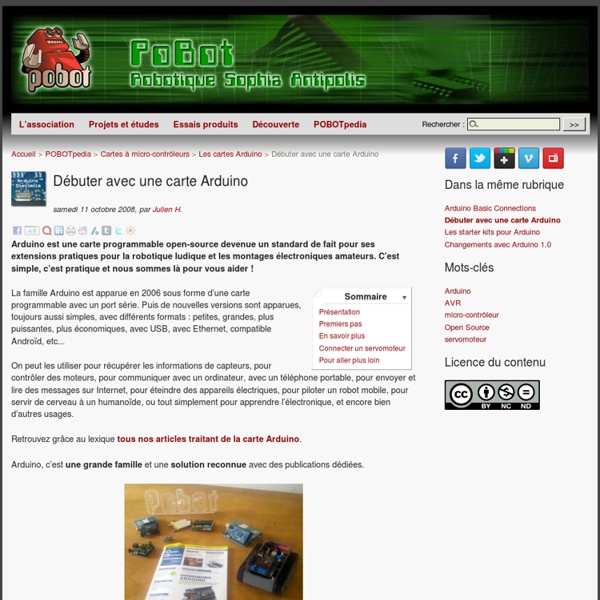Arduino pour bien commencer en électronique et en programmation
Bienvenue à toutes et à tous pour un tutoriel sur l'électronique et l'informatique ensemble ! Depuis que l’électronique existe, sa croissance est fulgurante et continue encore aujourd’hui. Si bien que faire de l’électronique est devenu accessible à toutes personnes en ayant l’envie. Mais, le manque de cours simples sur le net ou en libraire empêche la satisfaction des futurs électroniciens amateurs ou professionnels et parfois empêche certains génies à se révéler ( ). Ce que nous allons apprendre aujourd'hui est un mélange d'électronique et de programmation. Nous allons, dans un premier temps, voir ce qu'est l'électronique et la programmation. Plan du cours Je vais détailler un peu le plan du cours. Apprentissage des bases Le cours est composé de façon à ce que les bases essentielles soient regroupées dans les premières parties. Après cela, vous aurez acquis toutes les bases nécessaires pour poursuivre la lecture sereinement. Ce n'est pas tout ! Paré pour commencer l'aventure ?
Arduino tuto | reprapide.fr
Dans ce tutoriel on se propose d’allumer successivement deux LED par l’action d’un bouton-poussoir, chaque appui allumant l’une et éteignant l’autre. L’une des diodes est rouge et l’autre, verte, est allumée au lancement du programme. L’environnement de développement (IDE) est préalablement installé sous Linux, Mac OS X ou Windows. Un bouton, deux diodes et trois résistances Voici le montage : la plaque d’essais est alimentée par la carte elle-même (5V et masse),les cathodes des diodes sont reliées à la masse par l’intermédiare de deux résistances de 560 Ω, leurs anodes sont reliées aux pins 2 et 3 de la carte. Dessin réalisé avec Fritzing Code source Télécharger ce code [ Explication du code ] [ Replier ] • Lignes 1 à 3 : on initialise trois variables entières (mot-clé int) dont les valeurs représentent un pin du microcontrôleur : int ledRouge = 2;la LED rouge est branchée sur le pin 2,int ledVerte = 3;la LED verte sur le pin 3,int boutonPoussoir = 8;le bouton-poussoir sur le pin 8.
Travaux Pratiques Arduino
Introduction La plateforme utilisée pour les travaux pratiques est la carte Arduino. Préliminaires installez sur votre poste de travail l'environnement de développement Arduino installez sur votre poste de travail l'environnement de développement Processing optionnel : installez l'éditeur de montage Fritzing. Documentation Premières Manipulations Dans cette première partie, vous allez tester quelques programmes (appelés sketch) de base et les montages associés. Clignotement d'une LED Cette première manipulation permet de s'acclimater avec l'atelier Arduino, au chargement du programme sur la carte. L'Arduino Uno est équipé de 13 entrées-sorties digitales (0,1) d'une tension de 0V ou 5V. Cette manipulation montre la configuration d'une ES (13) en mode sortie (OUTPUT) et le positionnement en 0 ou 1 (LOW pour 0V et HIGH pour 5V). explications, code et montage Gradation d'une LED avec le PWM explications, code et montage Boutons poussoirs Potentiomètre Servomoteur
Arduino Tutorial - Learn electronics and microcontrollers using Arduino!
So, I get two or three emails a day, all basically asking the same thing: "Where can I learn about electronics?" In general, most of these people have seen some of my projects and want to be able to build similar things. Unfortunately, I have never been able to point them to a good site that really takes the reader through a solid introduction to microcontrollers and basic electronics. I designed this tutorial course to accompany the Arduino starter pack sold at the Adafruit webshop. Follow these lessons for happiness and prosperity. Lesson 0 Pre-flight check...Is your Arduino and computer ready? Here are some recommended tools: If you need to get any soldering done, you may also want.... All of the content in the Arduino Tutorial is CC 2.5 Share-Alike Attrib. Love it? To some extent, the structure of the material borrows from: The impressively good "What's a microcontroller?" "Spooky Arduino" - Todbot's excellent (if fast-paced!)
Arduino : Le cahier de programmation
De Wikidebrouillard. Traduction par Antony Auffret du "Arduino Programming Notebook", écrit et compilé par Brian W. Evans Ce cahier est une référence de programmation pratique, facile a utiliser pour la structure des programmes et les bases de la syntaxe du microcontroleur Arduino. Pour le garder simple, certaines exclusions ont été faites pour faire de ce cahier une référence, pour les débutants. Il est très utile comme source complémentaire de d'autres sites web, livres, ateliers ou classes. Cette décision a conduit à une sélection d'utilisations autonomes d'Arduino ce qui, par exemple, exclue les usages les plus complexes des tableaux ou des formes avancées de communication série. Ce livre débute avec les structure de base du langage de programme Arduino dérivé du C. Structure La structure de base du langage de programmation Arduino est assez simple et comprend au moins deux parties. void setup() { blocs d'instructions; } void loop() { blocs d'instructions; } Boucle du programme : loop() if
Arduino
Ce chapitre présente le langage Arduino, son vocabulaire ainsi que la structuration d'un programme écrit en Arduino. Le langage de programmation Un langage de programmation 1 est un langage permettant à un être humain d'écrire un ensemble d'instructions (code source) qui seront directement converties en langage machine grâce à un compilateur (c'est la compilation). L'exécution d'un programme Arduino s'effectue de manière séquentielle, c'est-à-dire que les instructions sont exécutées les unes à la suite des autres. Voyons plus en détail la structure d'un programme écrit en Arduino. La structure d'un programme Un programme Arduino comporte trois parties : la partie déclaration des variables (optionnelle) la partie initialisation et configuration des entrées/sorties : la fonction setup () la partie principale qui s'exécute en boucle : la fonction loop () Dans chaque partie d'un programme sont utilisées différentes instructions issues de la syntaxe du langage Arduino. Coloration syntaxique Exemple



